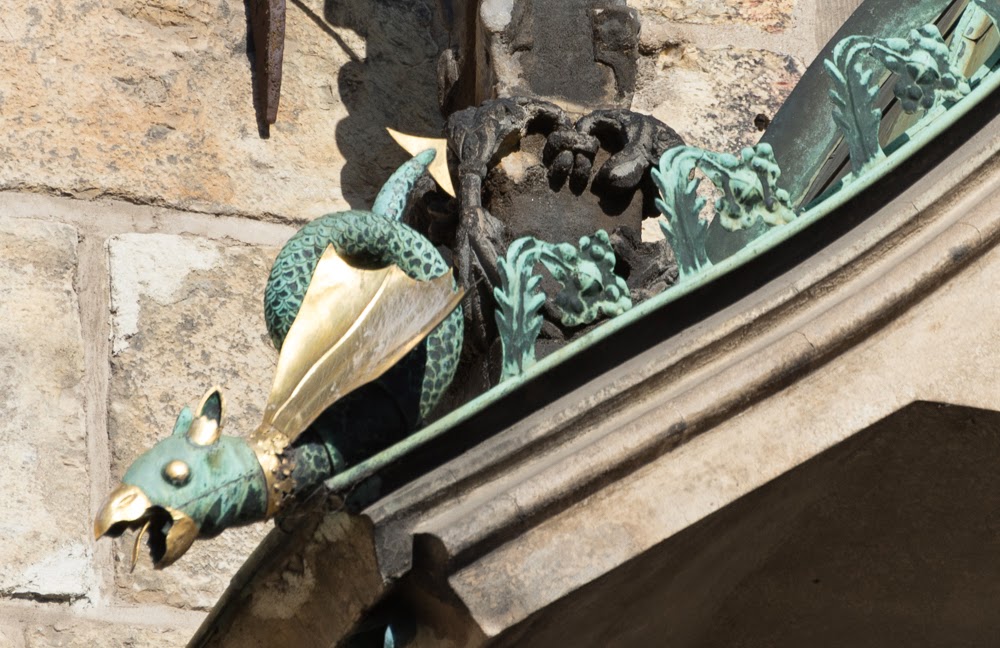Wenceslaus Square, Prague's biggest square, is just a block or so from our hotel. There's a central green with two large one-way streets forming the boundaries. Here part of the green is planted in flowers.
Martina is an architecture buff and told us much about the different styles and periods of the buildings on the square.
This ornate building has signs for Budweiser — the original Czech version, not the Anheiser Busch product. The Czech and American companies have an ongoing legal battle over trandmarks and licensing, and as a result the Czech beer cannot be sold in the US under the Budweiser (or Budvar, in Czech) name. It is available, but only under the "Czechvar" name.
Lots of Art Nouveau and Art Deco structures. I was struck by the faces on the facade of this building.
The Grand Hotel Europa, in all its glory, with interesting statuary on top.
Marks and Spencer, the British retailer, now occupies this building on the square, but years ago it was the a newspaper publisher. It was here in November 1989 that Václav Havel and Alexander Dubček addressed an enormous crowd in the square, from the balcony visible near the bottom of the photo. It was a significant event in the Velvet Revolution, and Havel and Dubček were to become, respectively, the President and Speaker of the Federal Parliament in the post-Communist government.
From the revolutionary to the truly mundane: an open-air McDonald's restaurant on the square.
Silhouette pedestrians on Czech traffic signs are more interesting than the ones on American signs.
I asked our guide if these were "Hero of the Revolution" style figures put up by the Communists, but she said no, they were just decorations appropriate to the period of the buildings.
A Segway rider again. I'm certain that she works for the Segway tour operator or Segway dealer, as she seemed to be giving sales pitches to people that asked about the machine.
The same two vintage autos I saw yesterday. These are used for taking tour groups around town. They look spiffier in the bright sunshine.
We passed this lovely church as we entered the Old Town. Since part of the building was in full sun and part in shade, this is a High Dynamic Range (HDR) composite of three images taken with different exposure settings.
You can ride a stretch limo to the cabaret, if you have enough money to spend there.
Martina recommended the Manufaktura store in the old town as a good place for hand-made articles and souvenirs that are not costly and are actually made in the Czech Republic rather than China or Taiwan. I concur; I've visited the shop on previous Prague trips and they have interesting and authentic things.
Small angel figures made mostly of corn husks.
The tiny medieval street that has the Manufaktura store leads into Old Town Square. It just before 11am, and the square is crowded with people waiting to see the clock's animated tolling of the hour.
The top of the clock tower (which has several more clocks). People can be seen in the viewing gallery just under the roof. It must be quite a view of Prague from there.
This is the "astronomical" part of the clock, with dials for the sun and moon.
We're in position to view the clock's animations now.
The clock strikes the hour. The two windows above the astronomical dial open, and twelve statues of religious figures parade past, six in each window.They all look very dour.
A figure representing death, appropriate for a medieval clock. The netting over the figures is to discourage birds from perching there.
I'll bet none of us has a downspout quite like this on our house.
In a window across from the clock, a permanent announcement of a concert. Apparently you can hear a saxophone at 8 every evening.
If you look up above the ground level, so that the cars and modern shops aren't visible, you're back in the 17th century.
Our guide with the statue of Jan Hus in the background.
Twin towers of the 14th-century Tyn Church, known officially as the Church of Our Lady before Týn. The "before Týn" part just means that the church is in front of that square. It's not actually on Old Town Square; there's a small passageway to get to the church from there.
St Nicholas Church, dating from 1735, is on Old Town Square and is undergoing renovation.
In the square itself, kids were having fun with the enormous bubbles that this man's apparatus created. I would imagine that he's selling them, and this is his advertising.
Another living statue. This guy isn't very good; he keeps moving.
Leaving the square, we walked through what used to be the medieval Jewish ghetto. The city fathers had all the buildings there except for churches and synagogues, leveled the ground several feet above it's old level to eliminate annual flooding, and re-laid out the streets. It's now a fancy part of town; notice that we're walking past the Cartier store.
A very fancy building, with an interesting statue on top.
Decoration on another apartment building. This is definitely a high-rent district.
One of the classic-car sightseeing tours zoomed past.
A window box with flowers, high up on the tower of a building. There are many such boxes on Prague buildings, many of them up high.
A memorial to Franz Kafka; he's the one sitting on the shoulders of the empty man. We would see another "empty man" statue later in the day.














































No comments:
Post a Comment